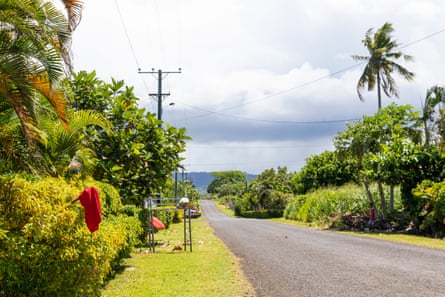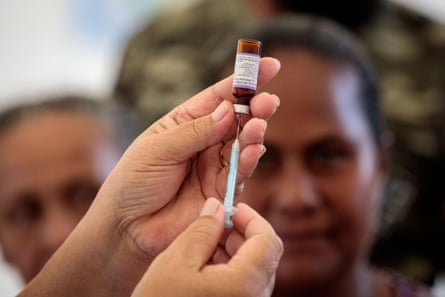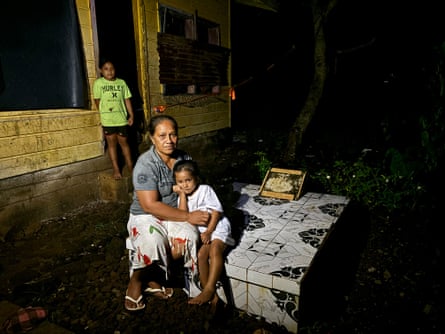The week before her three children died, Fa’aoso Tuivale and her husband took them for a swim in the river flowing behind their house in the Samoan village of Lauli’i.
Itila, 3, and his twin siblings, Tamara and Sale, 13 months, had a fever and their parents hoped to cool them down. The children were ill with measles and were not vaccinated. When they worsened, on a Sunday, Fa’aoso took them to hospital in Apia, 9km away. They were seen, and sent home.
The next day, they took Itila back to hospital. He died the same day. Tamara was admitted and died in intensive care the following Friday. Fa’aso was frightened by the sight of her tiny daughter, connected to so many tubes. She felt helpless. Sale was in better condition, so she took him home.
The family crushed fruit from the nonu tree for him to drink. They prayed upon him. They went to see a traditional healer, who held him under a tap.
“He was crying, and I grabbed him, wrapped a towel around him, held him to my heart and I knew he was gone,” Fa’aoso said, sitting on the grave of her children in the front yard of their banana and taro plantation. “I did everything I could.”
 View image in fullscreen
View image in fullscreen
In the small island country of Samoa, lives have been forever altered by an outbreak of the disease in 2019 that caused at least 83 deaths and 1,867 hospitalisations, mostly of babies and young children. Thousands more fell sick. The preventable illness was able to spread through the small, closely knit population of about 200,000 due to record low vaccination rates – stemming from a medical vaccination error, the Samoan government’s public health mismanagement, and fuelled by anti-vaccination sentiment, including by Donald Trump’s pick to lead the US health department, Robert F Kennedy Jr.
In Samoa these days, mothers are fearful.
“I’m always worried,” said Shuvourn Samuelu, who clutched her one-year-old son Leiato Samuelu in the emergency room of a hospital in Apia last week. She had brought him in to get a fever checked out. Five years ago, the hospital was overflowing when her son Lologa Samuelu, then 14 months, and nephew Isaako Junior, six months, died after complications from measles. They were not vaccinated.
“I knew they were sick, but I never thought they would die. We learned the hard way.”
Now, five years on from an epidemic that has traumatised a generation, Samoan health officials are among those sounding alarm over the nomination of Kennedy as US health secretary.
“We cannot and should not stay silent. We know what this appointment means. It means more platforms for anti-vaxxers and less funding for vaccines and health programmes,” Aiono Prof Alec Ekeroma, Samoa’s director general of health, told the Guardian.
“It must be treated as a threat to our health security.”
Kennedy’s visit to Samoa
The roots of the tragedy stretch back to July 2018 and the deaths of two babies due to a medical error in the administration of an MMR vaccine, after the vaccine powder was mixed with expired muscle relaxant anaesthetic instead of water. The government shut down the vaccination programme for 10 months to investigate – allowing thousands of babies to go unvaccinated, against World Health Organization advice, and creating space for rumours to take hold.
During the same period, Kennedy, who denies being anti-vaccine, had been hosted in Samoa. He visited four months before the measles outbreak was declared, in October 2019, meeting with government officials and anti-vaccine influencers in what health advocates and Ekeroma claim was a “significant disinformation campaign” stoking distrust in vaccines.
Kennedy and his wife, Cheryl Hines, were special guests at Samoa’s 57th independence celebrations in June 2019, as part of a trip that came about after the anti-vaccination non-profit group Kennedy founded, Children’s Health Defense, connected with vocal Samoan vaccine critic and traditional healer Edwin Tamasese.
 View image in fullscreen
View image in fullscreen
Tamasese was arrested during the measles epidemic for incitement against a government vaccination order. The charges against Tamasese were later dropped, with a judge citing insufficient evidence.
Kennedy, who would later hail Tamasese as a “hero” in a blog post and describe the epidemic as “mild”, also met with the Australian Samoan anti-vaccine influencer Taylor Winterstein. She posted a photo of the pair to her social media using anti-vax hashtags, saying his visit was “profoundly monumental” for the movement.
Months after his visit, Kennedy wrote a letter to then-Samoan prime minister Tuilaepa Sailele Malielegaoi urging him to consider if children’s deaths were caused by a “defective” vaccine or a “mutant strain” of measles caused by it. Neither is plausible.
Emails sent to Kennedy’s team and Children’s Health Defense went unanswered. A man who answered the phone at a press number for Kennedy said he would not be giving media interviews until after confirmation.
Vaccine misinformation spreads
Samoa is a deeply Christian nation, where traditional cultural practices, such as natural healing, find their home alongside “palagi”, or white, western medicine, which is still distrusted by many. A central government runs alongside a fa’a Matai (chief) system that sees society organised into villages where life is lived communally. The average hourly wage is US$1.30 (£1).
A fractured health system and lack of confidence in vaccines faced Dr Take Naseri as director general of health during the outbreak in 2019.
“We were caught, and it exposed all the gaps in our health system,” said Naseri, from his GP practice in Apia. There was a delay in announcing the outbreak, he said, because it took more than a fortnight to get confirmation of the first measles case. Asked why it took so long to re-establish the MMR vaccine programme, he said: “We had to stop it … We needed to rebuild confidence.”
He met with Kennedy during his visit, on Malielegaoi’s advice, for a discussion he said centred around Kennedy’s vaccine safety fears.
“He told me he thinks the data is not solid, but I told him with our small country we are very vulnerable to this disease. We are not rich. We don’t have the resources to manage it but we only have the resources to prevent it, which is what the vaccine does.”
Kennedy and his Children’s Health Defense group walked into this vacuum of mistrust – of western medicine, of the government – said Helen Petousis-Harris, a New Zealand-based vaccinologist and co-director of the Global Vaccine Data Network.
When the government did restart its vaccination programme, people were reluctant: when the epidemic was declared on 16 October, the rate had dropped to 31%, down from 84% four years previously, according to WHO data.
“The Samoan establishment handled the whole situation really badly and did not take the support and advice that was provided to them at the time, which is what allowed this to unravel and let RFK get in there,” Petousis-Harris said.
“When you get people who are wealthy and influential going into a fragile setting, it’s like the top of the food chain visiting and meeting up with those who act as the megaphone. The impact was devastating.” The resurgence of disease when vaccine rates go down is predictable, she said.
Kennedy has spread false claims that the MMR vaccines cause autism. According to the Centre for Countering Digital Hate, he is one of the world’s top disinformation super-spreaders. Public health officials in Samoa said anti-vaccination activists had been empowered by Kennedy, which had affected vaccine uptake.
 View image in fullscreen
View image in fullscreen
Photograph: Jack Taylor/Alamy
“The Samoan incident showed us how disinformation can kill,” said American paediatrician Dr Paul Offit, who has followed Kennedy’s anti-vaccine activism since 2005. “He sowed further distrust, he jumped all over it – he met with anti-vaxxers in Samoa to promote the notion that ‘it’s not measles, it’s the vaccine’, and immunisation rates dropped.”
In an interview for the movie Shot in the Arm, Kennedy denies any responsibility for falling vaccine rates. “I had nothing to do with people not vaccinating in Samoa. I never told anybody not to vaccinate. I didn’t, you know, go there for any reason to do with that.”
In November 2019, when New Zealand nurse and vaccine educator Lisbeth Alley joined mobile teams sent out to vaccinate Samoan villagers during a mass campaign, she said local nurses were still scared to give vaccines.
“Nobody had talked to them about it, nobody knew, so of course what do people think. It was a ripe environment to spread fear,” she said. As the measles took hold, distraught families were rushing to get vaccinated, Alley said. “As soon as they saw us coming they’d roll up their sleeves.”
And in developing countries, the suffering from measles is always worse. Many rural Samoans had no transport, feared going to hospital, or tried traditional healers first. By the time people did bring their babies in, they were extremely sick, said Australian anaesthetist Dr Dan Holmes, who led the Australian emergency medical team and was among more than 100 medical personnel deployed to Samoa in the thick of the epidemic.
 View image in fullscreen
View image in fullscreen
He spent two “relentless” weeks trying to save babies with complications from measles including pneumonia, collapsed lungs, dehydration, and brain inflammation.
“Your day might start at 6am with a baby who is unconscious and not breathing, and you might lose that baby, then there’s another one, day after day,” Holmes said. “It’s impacted me more than anything I’ve done. It makes me feel so angry that it could have been prevented.”
MMR vaccination in Samoa is now compulsory for babies over nine months. But in another small village outside Apia, where mother-of-eight Siiae Olilefauaitu sits on the grave of her one-year-old baby, Moana, in the encroaching dark, none of this is of any comfort.
Her family lives at the end of this muddy track without power. They use a gas cooker and go to bed at nightfall. They could move in with family elsewhere but Olilefauaitu doesn’t want to leave Moana, who is buried outside the front door.
“She is the first thing we see every day,” Olilefauaitu says. “She was a character, she was crawling, she smiled a lot. I can never forget her.”
∎